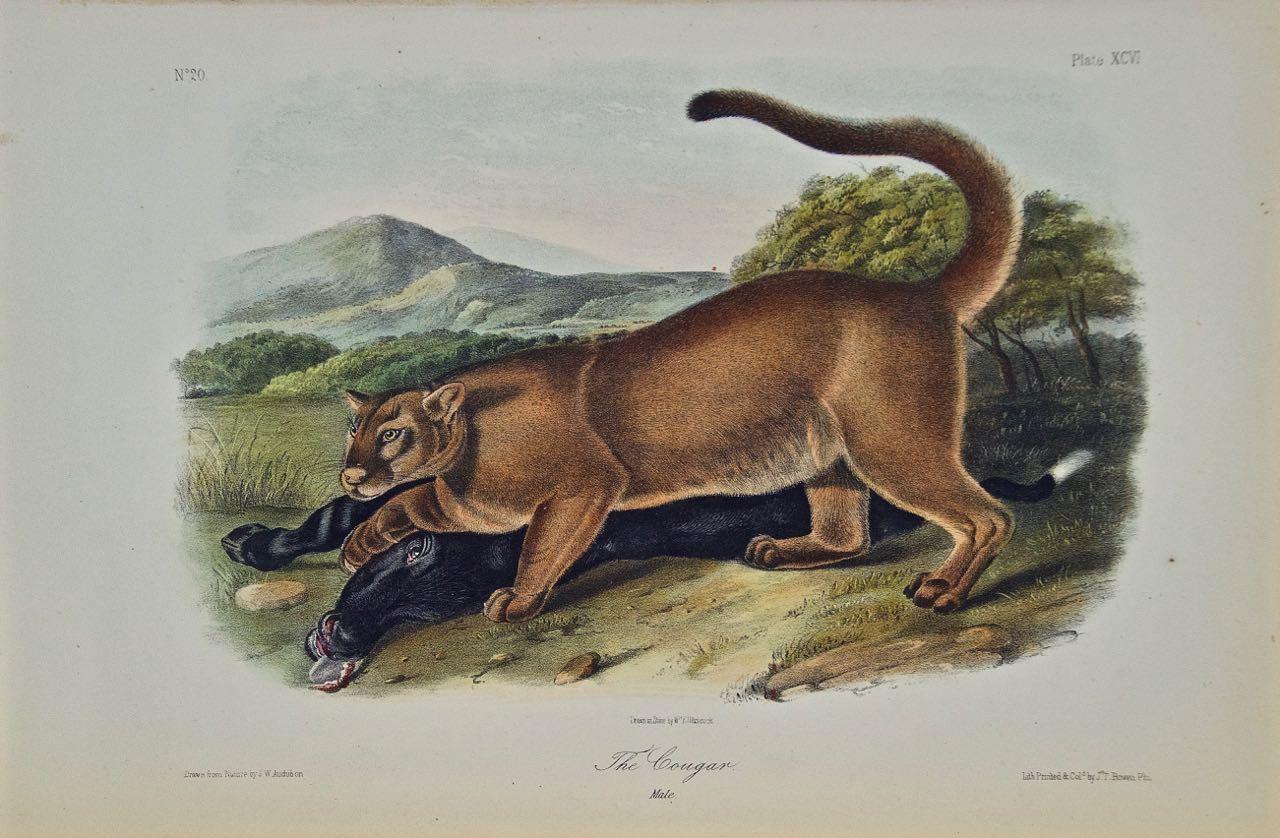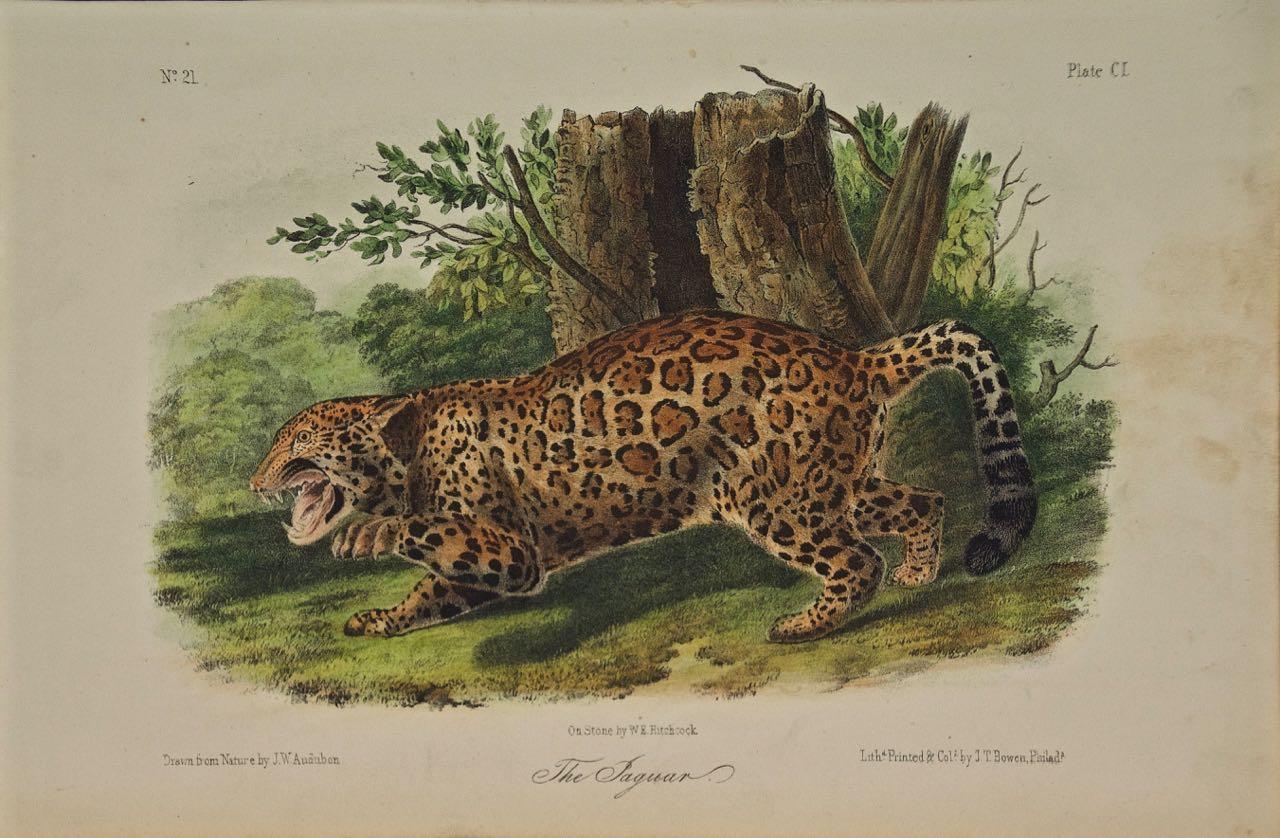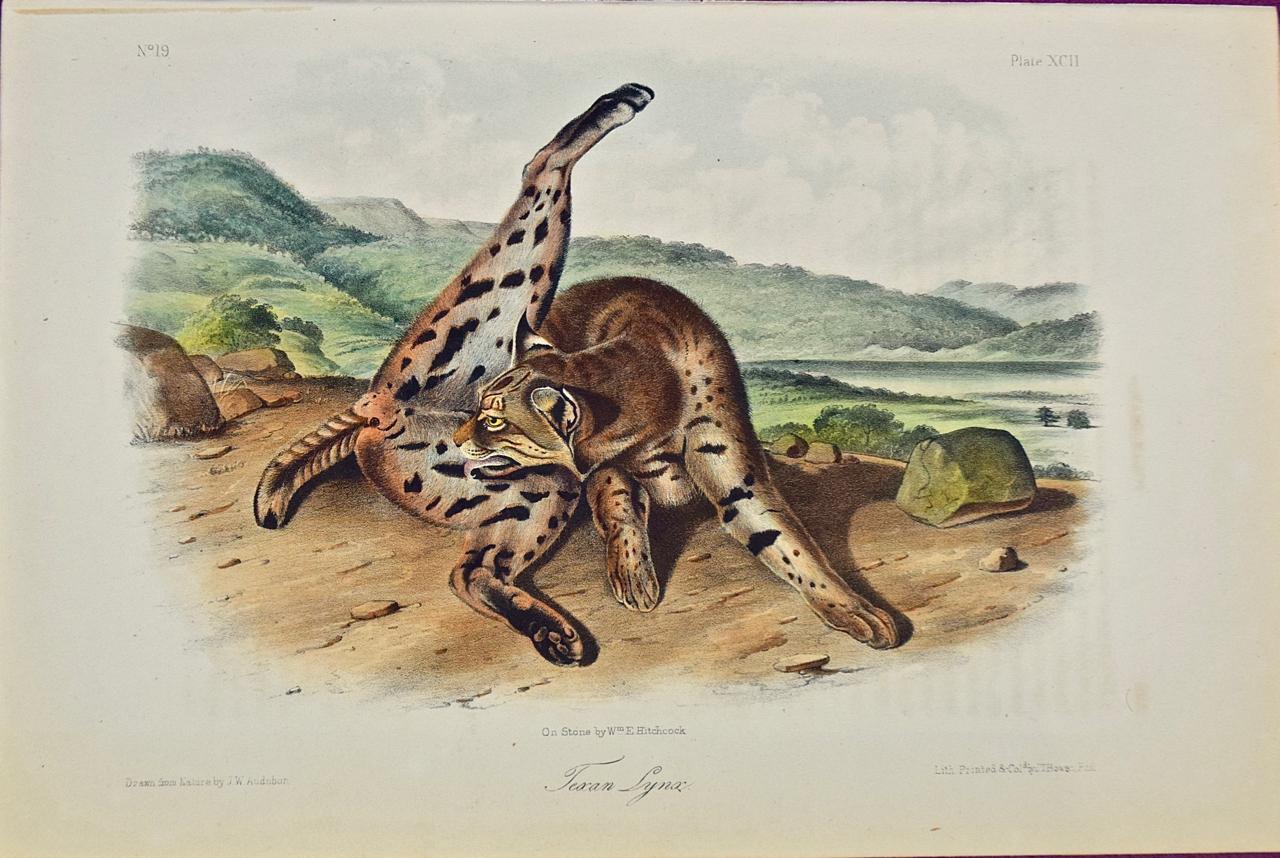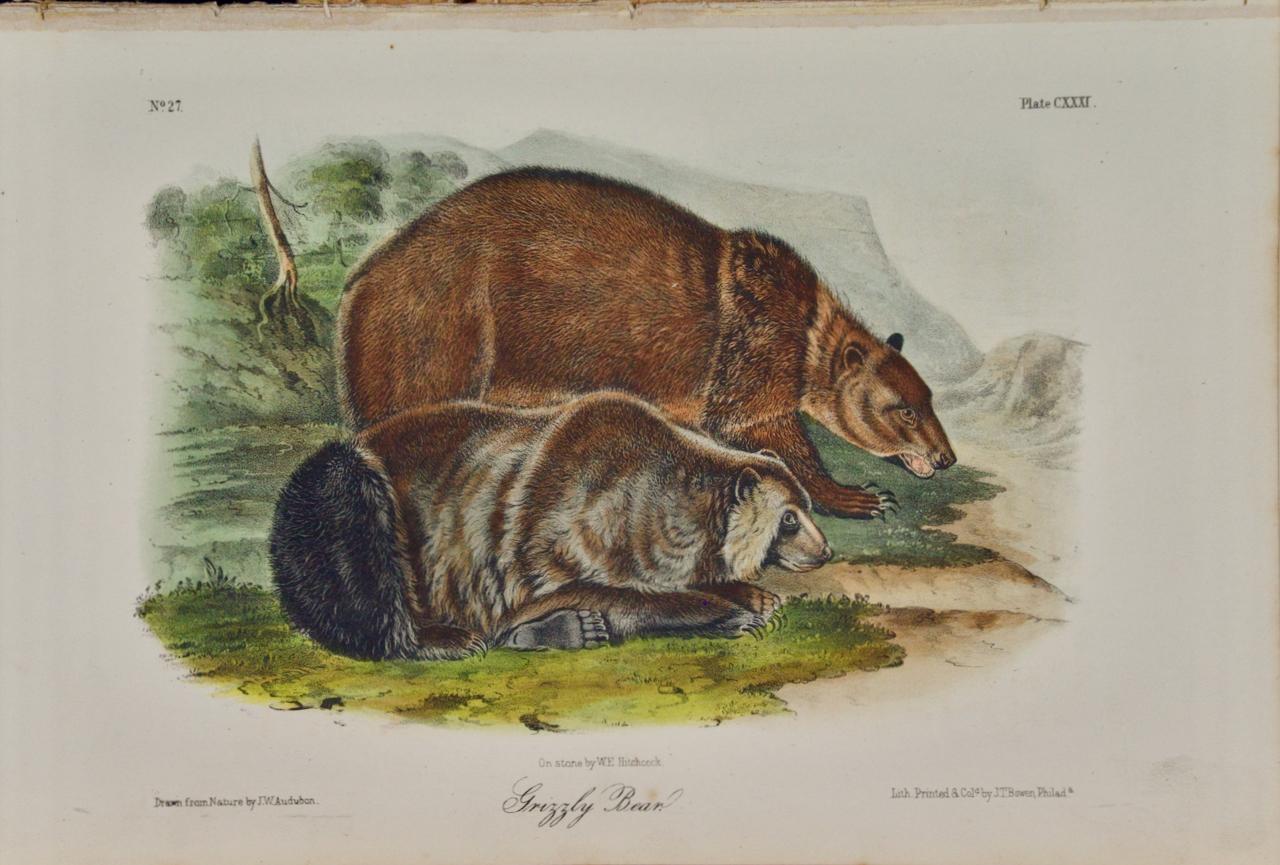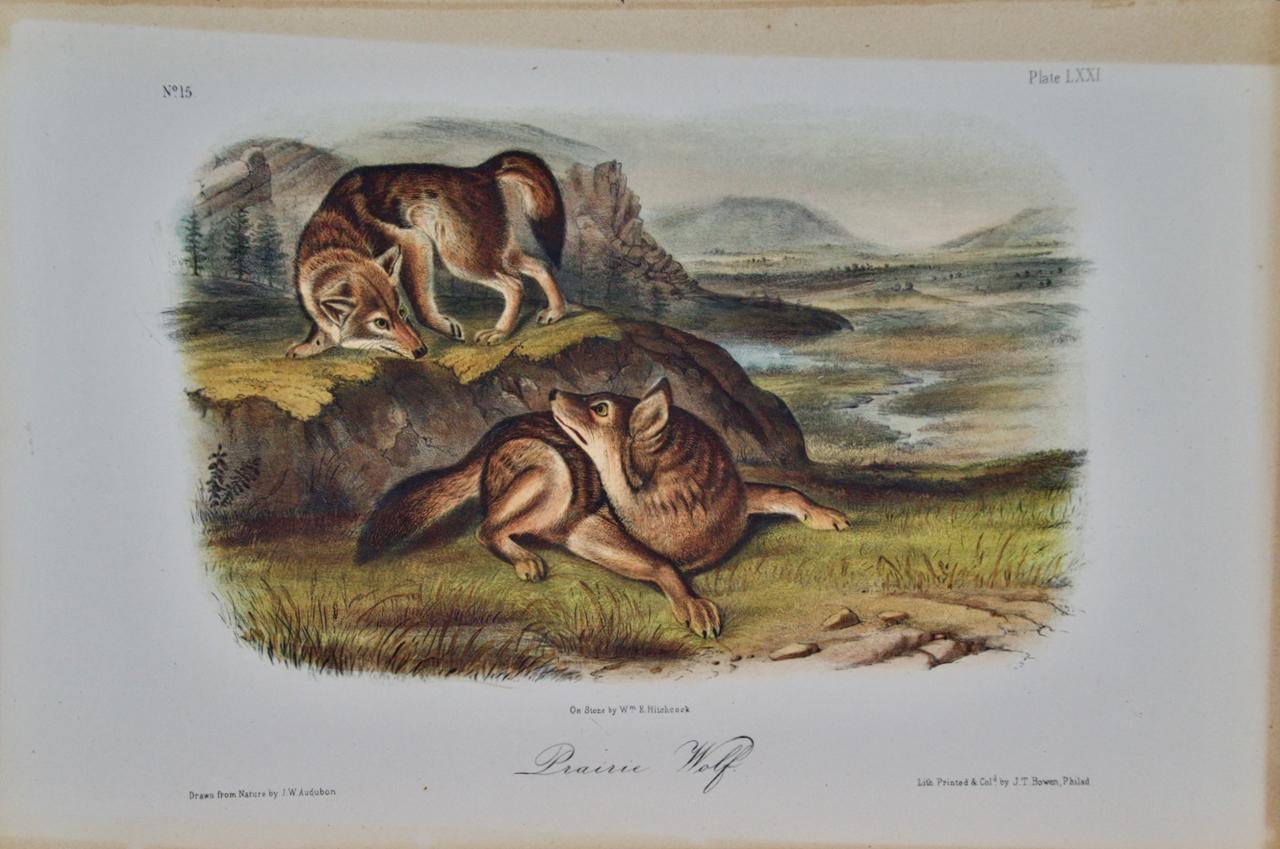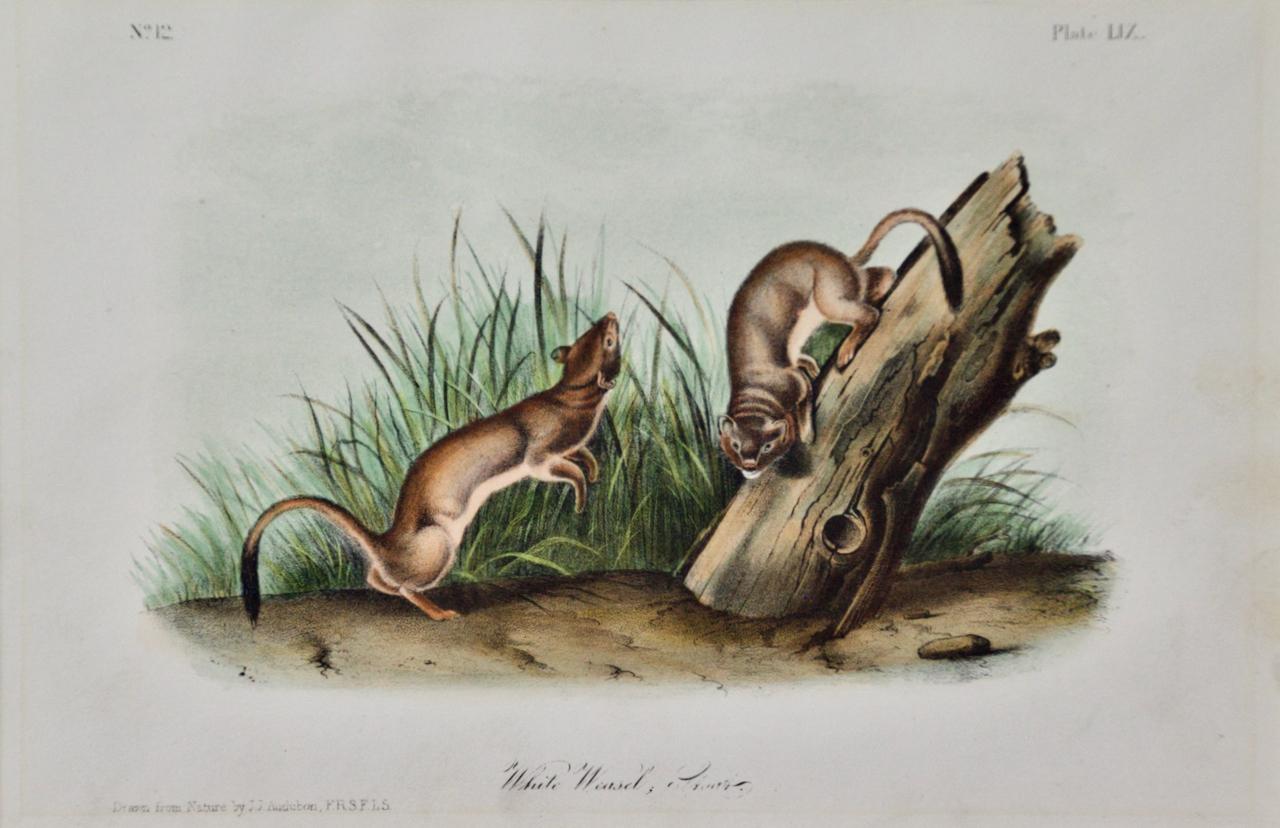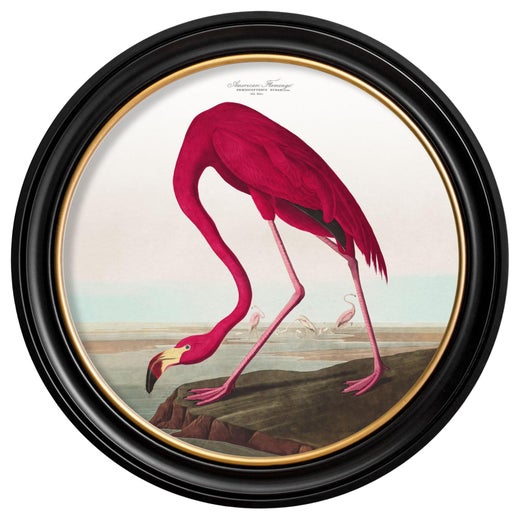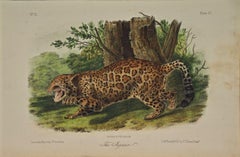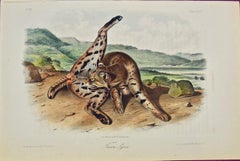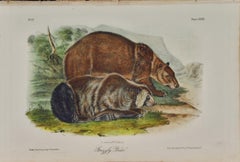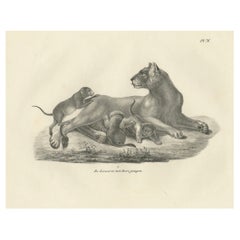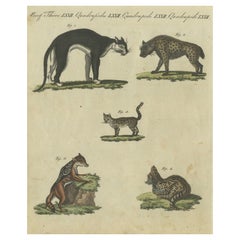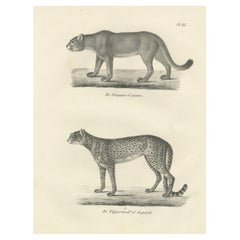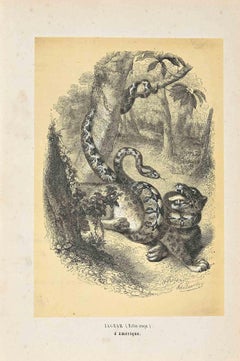Items Similar to "The Cougar, Female and Young": Original Audubon Hand-colored Lithograph
Want more images or videos?
Request additional images or videos from the seller
1 of 5
John James Audubon"The Cougar, Female and Young": Original Audubon Hand-colored Lithograph1849-1854
1849-1854
$975
£729.77
€843.26
CA$1,352
A$1,514.41
CHF 787.33
MX$18,699.96
NOK 10,029.92
SEK 9,481.73
DKK 6,292.88
Shipping
Retrieving quote...The 1stDibs Promise:
Authenticity Guarantee,
Money-Back Guarantee,
24-Hour Cancellation
About the Item
This is an original John James Audubon hand-colored royal octavo lithograph entitled "The Cougar, Female and Young", No. 20, Plate XCVII, 97 from Audubon's "Quadrupeds of North America". It was drawn on stone by William Hitchcock, printed and colored by J. T. Bowen and published in 1849-1854. It depicts a male cougar or mountain lion lying on the grass, cuddling a young cougar offspring. This beautiful landscape includes green grass and a hill and foliage in the background.
This original Audubon quadruped lithograph with vibrant hand-coloring is in excellent condition. The sheet measures 7" high by 10.5" wide. Descriptive text pages, 305-312, from Audubon's original publication are included.
John James Audubon (1785-1851) was a naturalist and artist. He was initially unsuccessful financially prior to the publication of his famous work “The Birds of America”, spending time in debtor’s prison, once stabbing a disgruntled investor in self-defense. However, his obsession with birds and art motivated him to persist in his goal of documenting every bird in America via his watercolor paintings and publishing his works for all to enjoy. Audubon's first illustrations were published in a large elephant folio size. Due to their expense they were purchased in rather small numbers by the wealthy. To reach a larger audience, Audubon, with the help of his sons and J. T. Bowen, published a smaller octavo sized lithograph version, which were much more affordable.
With the success of his bird projects, Audubon then turned his attention to four-legged animals. He explored the Missouri River in 1843 sketching the four-legged animals he encountered in their natural setting. His expedition covered some of the same regions recently explored by Lewis and Clark, traveling from present day Alaska to Mexico. Audubon realized that this was an opportunity to document these animals in the still relatively pristine American wilderness, before man encroached on their environment.
Between 1845 and 1848, Audubon and his sons John Woodhouse Audubon and Victor Gifford Audubon produced a set of elephant folio sized lithographs that were primarily engraved and hand colored by J. T. Bowen in Philadelphia. The publication, which included text descriptions of the animals was published 3 years before Audubon died. As with the birds, this was followed by a three-volume set of 155 octavo-sized plates entitled “The Quadrupeds of North America” completed and published by Audubon’s sons, John, Jr. and Victor.
Audubon prints continue to be popular and a wise investment. The double elephant folio set “The Birds of America” have sold at auction for as much as $8.8 million, and individual plates may sell for six figures. The beautiful octavo sized plates are not as expensive, but becoming more sought after, as the folio bird plates become unattainable to all but the very wealthy.
- Creator:John James Audubon (1785-1851, American, French)
- Creation Year:1849-1854
- Dimensions:Height: 7 in (17.78 cm)Width: 10.5 in (26.67 cm)
- Medium:
- Movement & Style:
- Period:
- Framing:Framing Options Available
- Condition:
- Gallery Location:Alamo, CA
- Reference Number:Seller: # 22971stDibs: LU1173210456362
John James Audubon
John James Audubon (April 26, 1785, Les Cayes, Saint-Domingue (later Haiti) – January 27, 1851 (aged 65) Manhattan, New York, U.S.), born Jean-Jacques Audubon, was an American ornithologist, naturalist, and painter. He was notable for his expansive studies to document all types of American birds and for his detailed illustrations that depicted the birds in their natural habitats. His major work, a color-plate book entitled The Birds of America (1827–1839), is considered one of the finest ornithological works ever completed. Audubon identified 25 new species.
About the Seller
5.0
Platinum Seller
Premium sellers with a 4.7+ rating and 24-hour response times
Established in 2011
1stDibs seller since 2019
285 sales on 1stDibs
Typical response time: 2 hours
- ShippingRetrieving quote...Shipping from: Alamo, CA
- Return Policy
Authenticity Guarantee
In the unlikely event there’s an issue with an item’s authenticity, contact us within 1 year for a full refund. DetailsMoney-Back Guarantee
If your item is not as described, is damaged in transit, or does not arrive, contact us within 7 days for a full refund. Details24-Hour Cancellation
You have a 24-hour grace period in which to reconsider your purchase, with no questions asked.Vetted Professional Sellers
Our world-class sellers must adhere to strict standards for service and quality, maintaining the integrity of our listings.Price-Match Guarantee
If you find that a seller listed the same item for a lower price elsewhere, we’ll match it.Trusted Global Delivery
Our best-in-class carrier network provides specialized shipping options worldwide, including custom delivery.More From This Seller
View All"The Cougar", an Original 19th C. Audubon Hand Colored Quadruped Lithograph
By John James Audubon
Located in Alamo, CA
This is an original John James Audubon hand-colored royal octavo lithograph entitled "The Cougar, Male", No. 20, Plate XCVI, 96 from Audubon's "Quadrupeds of North America". It was d...
Category
Mid-19th Century Naturalistic Animal Prints
Materials
Lithograph
"The Jaguar", an Original 19th C. Audubon Hand Colored Quadruped Lithograph
By John James Audubon
Located in Alamo, CA
This rare original John James Audubon hand-colored royal octavo lithograph is entitled "The Jaguar", No. 21, Plate CI, 101 from Audubon's "Quadrupeds of North America". It was drawn ...
Category
Mid-19th Century Naturalistic Animal Prints
Materials
Lithograph
"Texan Lynx": An Original Audubon 19th Century Hand-Colored Quadruped Lithograph
By John James Audubon
Located in Alamo, CA
This is an original 19th century John James Audubon hand-colored lithograph entitled "Texan Lynx", No. 19, Plate XCII, 92, from Audubon's "Quadrupeds of North America", printed and colored by J.T. Bowen and published in Philadelphia from 1849-1854. The lithograph depicts a Texan Lynx laying on the ground with hills in the background.
This antique hand colored Audubon quadruped lithograph is presented with the original descriptive text pages 293-296 from Audubon's 19th century publication. The print is in excellent condition, including the striking hand coloring.
John James Audubon (1785-1851) was a naturalist and artist. He was initially unsuccessful financially prior to the publication of his famous work “The Birds of America”, spending time in debtor’s prison, once stabbing a disgruntled investor in self-defense. However, his obsession with birds and art motivated him to persist in his goal of documenting every bird in America via his watercolor paintings and publishing his works for all to enjoy. Audubon's first illustrations were published in a large elephant folio size. Due to their expense they were purchased in rather small numbers by the wealthy. To reach a larger audience, Audubon, with the help of his sons and J. T. Bowen, published a smaller octavo sized lithograph version, which were much more affordable.
With the success of his bird projects, Audubon then turned his attention to four-legged animals. He explored the Missouri River in 1843 sketching the four-legged animals he encountered in their natural setting. His expedition covered some of the same regions recently explored by Lewis and Clark, traveling from present day Alaska to Mexico. Audubon realized that this was an opportunity to document these animals in the still relatively pristine American wilderness, before man encroached on their environment.
Between 1845 and 1848, Audubon and his sons John Woodhouse Audubon and Victor Gifford Audubon produced a set of elephant folio sized lithographs that were primarily engraved and hand colored by J. T. Bowen in Philadelphia. The publication, which included text descriptions of the animals was published 3 years before Audubon died. As with the birds, this was followed by a three-volume set of 155 octavo-sized plates entitled “The Quadrupeds of North America” completed and published by Audubon’s sons, John, Jr. and Victor.
Audubon prints continue to be popular and a wise investment. The double elephant folio set...
Category
Mid-19th Century Naturalistic Animal Prints
Materials
Lithograph
"Grizzly Bear", an Original 19th C. Audubon Hand Colored Quadruped Lithograph
By John James Audubon
Located in Alamo, CA
This is an original John James Audubon hand-colored royal octavo lithograph entitled "Grizzly Bear", No. 27, Plate CXXXI from Audubon's "Quadrupeds of North America". It was drawn on...
Category
Mid-19th Century Naturalistic Animal Prints
Materials
Lithograph
"Prairie Wolf": An Original Audubon 19th Century Hand-colored Lithograph
By John James Audubon
Located in Alamo, CA
This is an original John James Audubon hand-colored royal octavo lithograph entitled "Prairie Wolf", No. 15, Plate LXXI, 71 from Audubon's "Quadrupeds of North America". It was drawn...
Category
Mid-19th Century Naturalistic Animal Prints
Materials
Lithograph
White Weasel Sloat: An Original 19th Century Hand-colored Lithograph by Audubon
By John James Audubon
Located in Alamo, CA
This is an original John James Audubon hand-colored lithograph entitled "White Weasel Slout, No. 12, Plate LIX" from John James Audubon's Quadrupeds of North America, published in Ph...
Category
Mid-19th Century Naturalistic Animal Prints
Materials
Lithograph
You May Also Like
19th-Century Lithograph of a Lioness with Her Playful Cubs in the Wild
Located in Langweer, NL
19th-Century Lithograph of a Lioness with Her Playful Cubs in the Wild
This tender 19th-century lithograph beautifully captures a lioness (De Leeuwin) with her young cubs (hare jo...
Category
Antique 1830s Prints
Materials
Paper
Striking 1805 Hand-Colored Engraving of Wild Cats and Predatory Mammals
Located in Langweer, NL
Striking 1805 Hand-Colored Engraving of Wild Cats and Predatory Mammals from Bertuch
Description: This remarkable hand-colored engraving from Friedrich Justin Bertuch’s *Porte-Fe...
Category
Antique Early 1800s Prints
Materials
Paper
19th-Century Lithograph of the Puma and Cheetah in Graceful Stances
Located in Langweer, NL
19th-Century Lithograph of the Puma and Cheetah in Graceful Stances
This exquisite 19th-century lithograph showcases two remarkable big cats: the cougar, or puma (De Couguar of puma), and the cheetah, referred to as the "tiger wolf" (De Tijgerwolf of Gepard). Originally published in *De Zoogdieren: afgebeeld en in hunne levenswijze geschetst*, this illustration captures the physical differences between these two agile predators with remarkable accuracy.
The puma (Puma concolor), also known as the mountain lion, is native to the Americas, ranging from Canada to Patagonia. Unlike other big cats, pumas lack the ability to roar, making them more closely related to smaller feline species. They are solitary hunters known for their stealth and adaptability to various terrains, from dense forests to arid deserts.
The cheetah (Acinonyx jubatus...
Category
Antique 1830s Prints
Materials
Paper
Jaguar - Original Lithograph by Paul Gervais - 1854
By Paul Gervais
Located in Roma, IT
Jaguar is an original lithograph on ivory-colored paper, realized by Paul Gervais (1816-1879). The artwork is from The Series of "Les Trois Règnes de la Nature", and was published in...
Category
1850s Modern Figurative Prints
Materials
Lithograph
$207 Sale Price
25% Off
Original Antique Print of a Lioness and Lion Cubs by Ridinger
Located in Langweer, NL
Beautiful original old print of a lioness and lion cubs. This print originates from Dr. Johann Schreber's 'Die Saugthiere in Abbildungen nach der Natur'(Mammals in Pictures after Nature). Drawn by Johann Elias Ridinger (1698–1767).
Johann Christian Daniel von Schreber (1739–1810) was appointed professor of materia medica at the University of Erlangen in 1769. In 1774, he began writing a multivolume set of books entitled Die Säugethiere in Abbildungen nach der Natur mit Beschreibungen, which focused on the mammals of the world. Many of the animals included were given a scientific name for the first time, following the binomial system of Carl Linnaeus. From 1791 until his death in 1810, he was the president of the German Academy of Sciences Leopoldina. He was elected a member of the Royal Swedish...
Category
Antique Late 18th Century Prints
Materials
Paper
$279 Sale Price
20% Off
19th-Century Lithograph of a Lioness, Her Cubs, and Their Caretaker
Located in Langweer, NL
19th-Century Lithograph of a Lioness, Her Cubs, and Their Caretaker
This unique 19th-century lithograph depicts an unusual yet tender interaction between a lioness, her young cubs...
Category
Antique 1830s Prints
Materials
Paper
